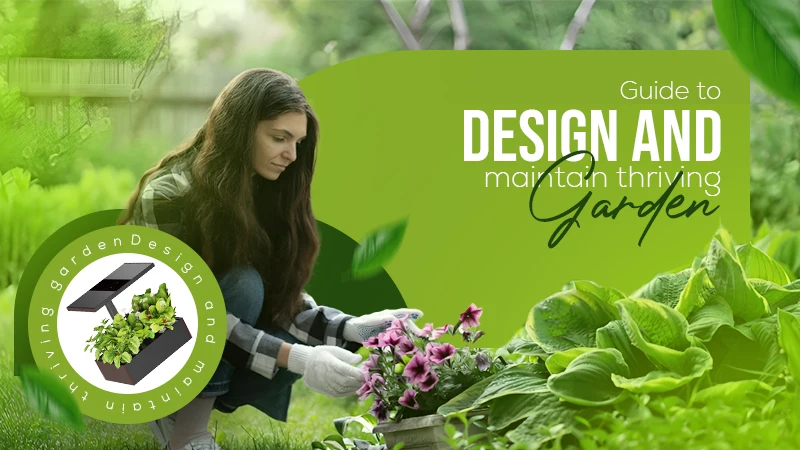Are you a fan of the old Victorian era? Or the classic Gothic literature filled with psychic, mysterious vibes? Or the ancient tombstones are your go-to place? Then, why don’t you bring all of this horror, suspense, and tragic trysts to your garden with Gothic flowers?
You can design a ‘Goth Garden’ incorporated with the themes of death and decay to take a walk through freshly dug pathways, spooky plants, custom neon signs and dark flowers.
To give your garden a perfect blend of pretty and perky looks, we’ve presented a list of dark and black flowers that will give visitors a spine-chilling experience.
Black Dahlia
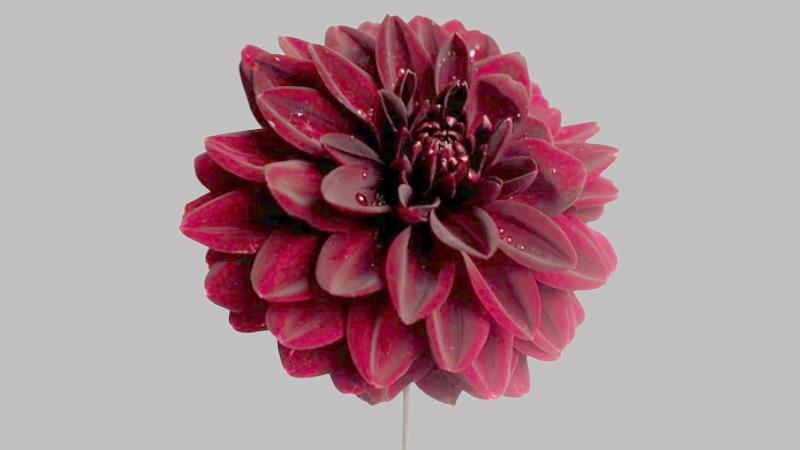
With petals curved inside, the Black Dahlia is a very deep burgundy to dark chocolate flower, having a yellow eye at the center. You can place the Black Dahlia plant as the centerpiece of the garden during summer and then use it for indoor decoration during winter.
Arabian Night, Black Jack, Black Satin, Karma Choc, and Black Embers are some other varieties of it to give a dark addition to your garden.
| Botanical Name | Dahlia x pinnata cultivars |
| Mature Size | 32–40 inches tall |
| Soil Conditions | Moist and well-drained |
| Watering Requirements | In every 1-2 week |
| Sunlight Exposure | Full sun |
| Bloom Time | Summer to autumn |
Black Roses
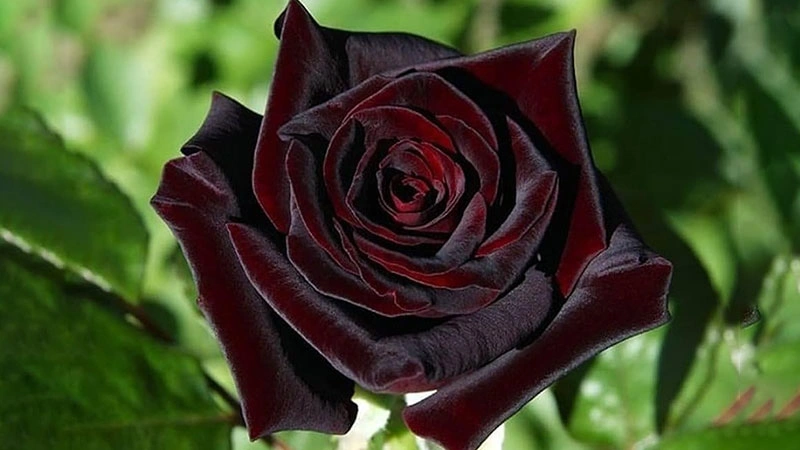
These mysterious and beautiful flowers are a great source to create a gothic environment in your garden. The flower has a dark maroon-to-black hue, with around 45 petals and glossy leaves. You can opt for their subgroups like Black Magic Rose, Black Velvet Rose, Black Baccara Rose, Black Jade Rose, and Black Ice to bring romantic vibes and attract pollinators.
| Botanical Name | Rosa ‘Black Baccara’ |
| Mature Size | 3-4 feet tall |
| Soil Conditions | Well-drained |
| Watering Requirements | 0.8 cup of water in every 12 days |
| Sunlight Exposure | Full sun |
| Bloom Time | Late spring to fall |
Black Calla Lily
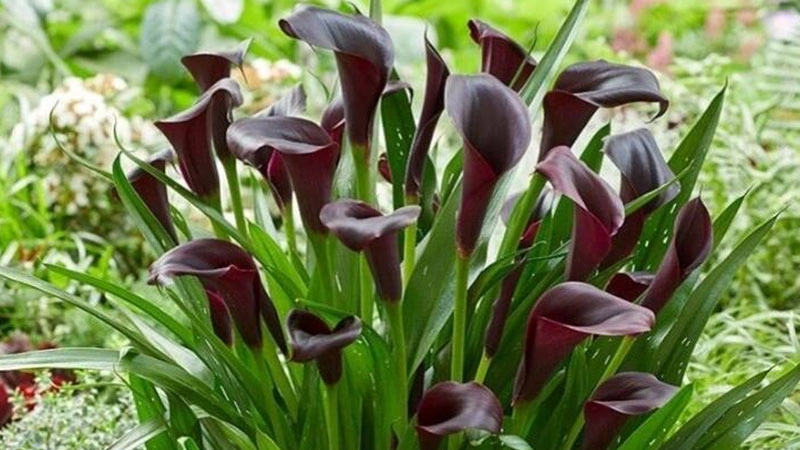
Having bell-shaped black to deep purple flowers, they are also called Black Star. Black Calla Lily needs plenty of water to flourish and can be used to grow as summer bulbs, garden beds, and containers. Some other extremely dark varieties of these callas are Edge of Night and Odessa.
| Botanical Name | Zantedeschia ‘Black Star’ |
| Mature Size | Up to 2 feet tall |
| Soil Conditions | Moist and well-drained |
| Watering Requirements | 1-2 times per week |
| Sunlight Exposure | Full sun to partial shade |
| Bloom Time | Summer |
Black and Blue Sage
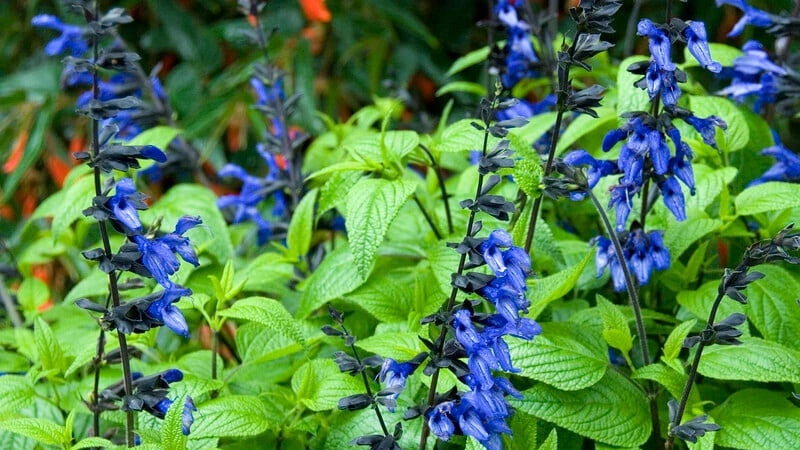
Also called Black and Blue Anise-scented Sage, Black and Blue Salvia, Brazilian Anise Sage, and Blue Anise Sage, the plant has electric blue flowers contrasting with black stems. You can plant another variety of Black and Blue Sage, Salvia Bodacious ‘Rhythm and Blues’ in beds, borders, containers, and cottage gardens.
| Botanical Name | Salvia guarantica ‘Black and Blue’ |
| Mature Size | 2 to 5 feet |
| Soil Conditions | Well-drained |
| Watering Requirements | 0.8 cup of water in every 9 days |
| Sunlight Exposure | Full Sun to Part Shade |
| Bloom Time | Late Summer to Fall |
Black Bachelor’s Buttons
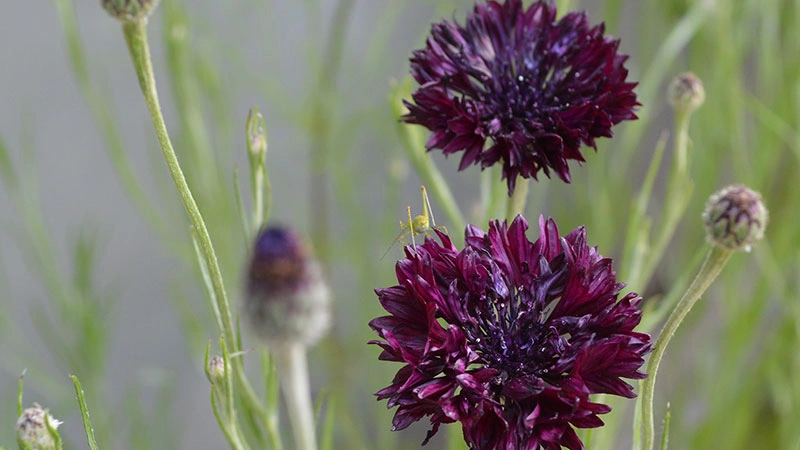
Bachelor’s buttons are fast-growing annual plants also called cornflowers. These Gothic flowers can bloom 6 to 8 weeks after sowing and are edible as well. The flower got its name from the tradition of placing the cut flower in the buttonhole by the bachelors when they went courting.
You can grow these deep, dark garnets or crimson-black flowers in cut arrangements or classic cottage gardens. Also, the dried petals of the flowers can be used to make watercolors or food dye.
| Botanical Name | Centaurea cyanus cultivars |
| Mature Size | Up to 3 feet |
| Soil Conditions | Well-drained |
| Watering Requirements | 1 inch per week |
| Sunlight Exposure | Partial to full sun |
| Bloom Time | Late spring to early summer |
Black Bearded Iris
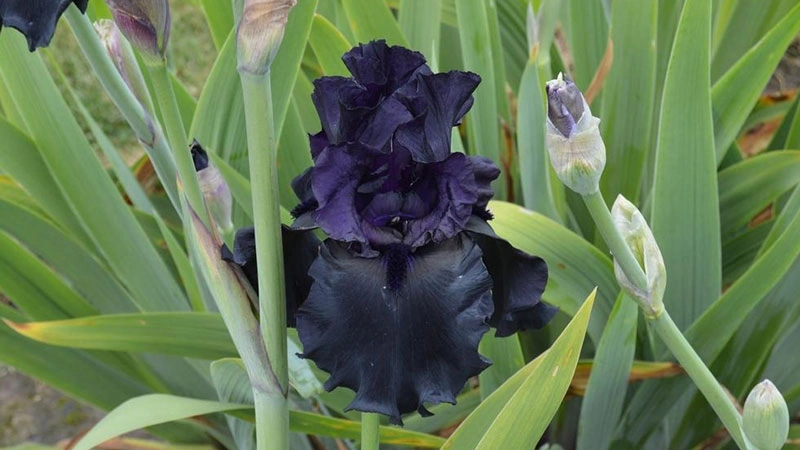
These hardy perennials can be planted indoors to bloom for longer, or else they can be used for the settings of cut arrangements and borders to get a Gothic presentation. Also known as Hello Darkness and Blackwater, Black Bearded Iris blooms massively and can add a great contrast among colorful flowers.
| Botanical Name | Iris germanica |
| Mature Size | 2-4 feet tall |
| Soil Conditions | Well-drained |
| Watering Requirements | Every week |
| Sunlight Exposure | Full sun to partial shade |
| Bloom Time | Late spring to early summer |
Black Velvet Petunia
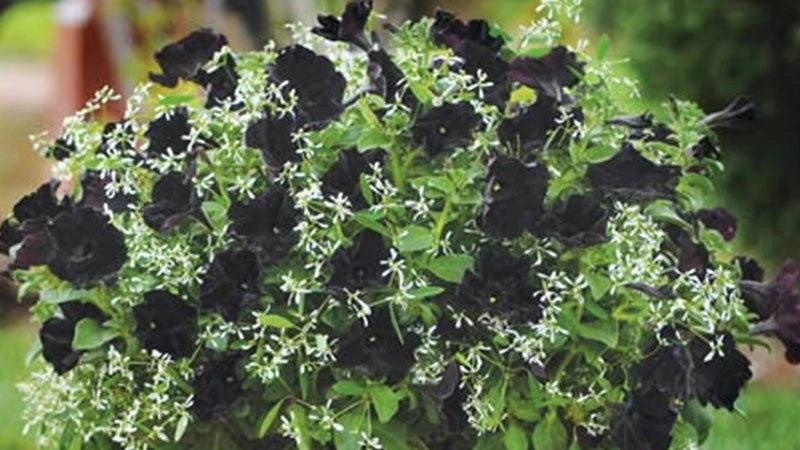
These fast-growing flowers can beautifully complement bright colors well in your garden or balcony as hanging baskets, containers, and flower beds. Also known as Petunia Black Magic, Black Velvet Petunia can be contrasted with several other varieties during spring and fall. The trumpet-shaped flower is bathed in black and its leaves remain green throughout the season.
| Botanical Name | Petunia ‘Black Velvet’ |
| Mature Size | Up to 12 inches tall |
| Soil Conditions | Well-drained |
| Watering Requirements | Once or twice a week |
| Sunlight Exposure | Full sun |
| Bloom Time | Spring to fall |
Black Columbine
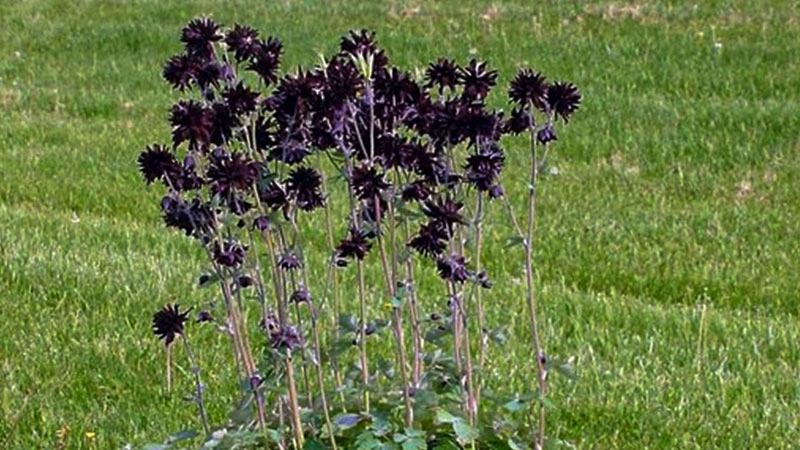
Often referred to as Columbine Black Barlow, Granny’s Bonnet Black Barlow, or Clematis-flowered Columbine Black Barlow are easy-to-grow plants with black to deep purple blooms. These short-lived perennials are welcomed additions to beds, borders, rock gardens, shade gardens, or neutralized areas. You can complement Black Columbine with irises, alliums, roses, and peonies to give your garden stunning visuals.
| Botanical Name | Aquilegia vulgaris and A. x hybrida cultivars |
| Mature Size | Up to 3 feet (0.91 m) |
| Soil Conditions | Moist to well-drained |
| Watering Requirements | 0.8 cup of water in every 9 days |
| Sunlight Exposure | Full sun to partial sun |
| Bloom Time | Late spring to early summer |
Andean Silver-Leaf Sage
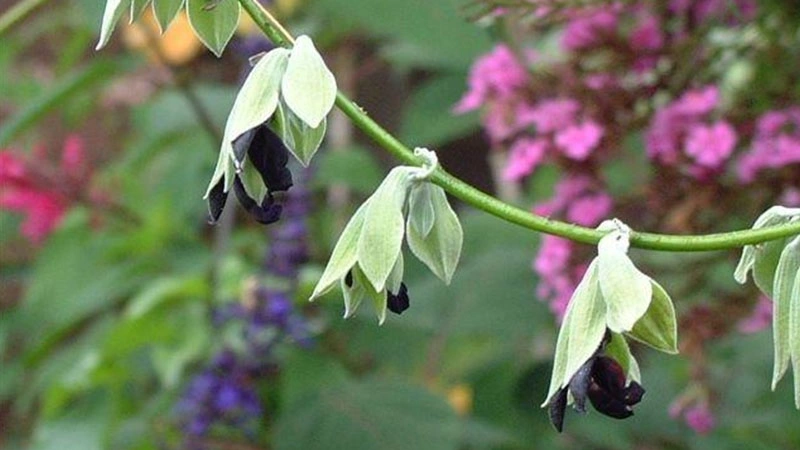
The plant blooms with arching spikes of purple-black parrot’s beak flowers with pistachio-green calyces. But what draws attention is its silvery leaves and stems, which are densely cloaked in white hair. They are the showiest plants for annual borders, mixed borders, and containers, and they attract butterflies and hummingbirds.
| Botanical Name | Salvia Discolor |
| Mature Size | 1 to 3 feet |
| Soil Conditions | Dry to Medium |
| Watering Requirements | 0.8 cup of water in every 9 days |
| Sunlight Exposure | Full sun |
| Bloom Time | Early fall to summer |
Black Hellebore
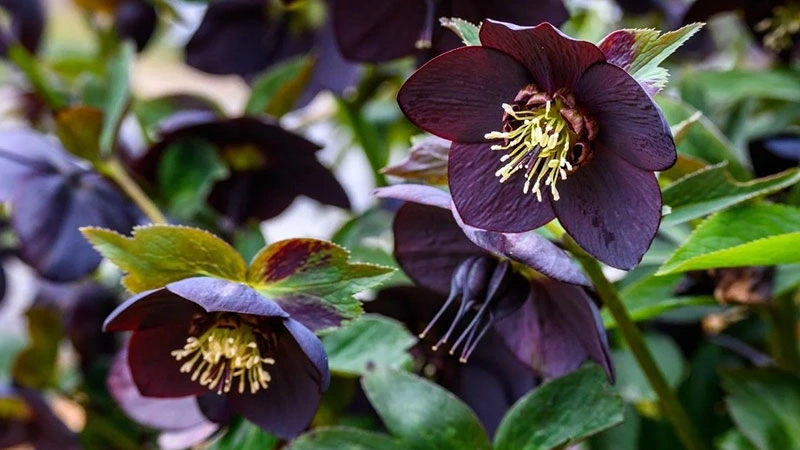
These are the early active bloomers, also called Midnight Ruffles, Christmas Rose, and Lenten Rose. They have ruffled petals of deep purple color and yellow stamens at the center. Black hellebores are a great pick for shady woodland gardens. You can also opt for some hybrid hellebores, such as hybridus black, onxy odessy, black diamond, and slate, for having a Gothic look.
| Botanical Name | Helleborus niger |
| Mature Size | 12-18 inches tall |
| Soil Conditions | Well-drained, rich soil |
| Watering Requirements | 1 inch of water every week |
| Sunlight Exposure | Partial to full shade |
| Bloom Time | Late winter to early spring |
Black Ranunculus
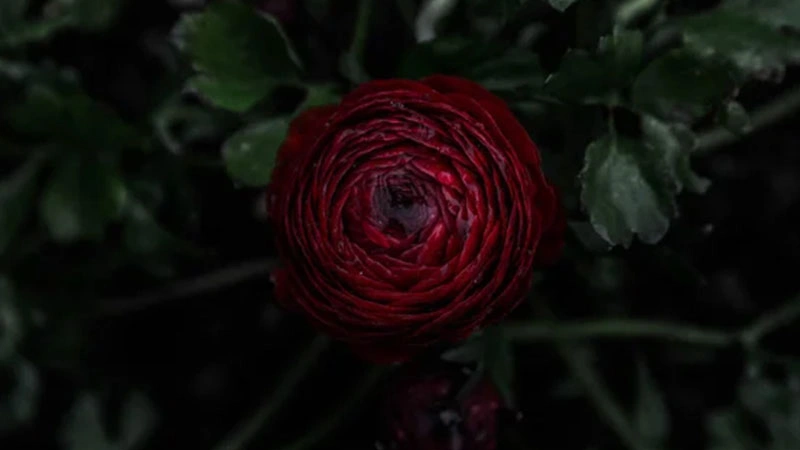
Also called Persian Buttercup, Black Ranunculus are deep burgundy flowers with annual and perennial life cycles. You can give a more charismatic presentation to your Gothic, container, and cut flower garden and resonate aesthetic appeal by complementing Black Ranunculus with roses and tulips. Their rose-like, paper-thin petals and fragrance also attract bees and other pollinators.
| Botanical Name | Ranunculus sceleratus |
| Mature Size | 12 to 15 inches |
| Soil Conditions | Well-drained to moist |
| Watering Requirements | 1-2 inch of water every week |
| Sunlight Exposure | Full sun |
| Bloom Time | Late spring to summer |
Black Hoya
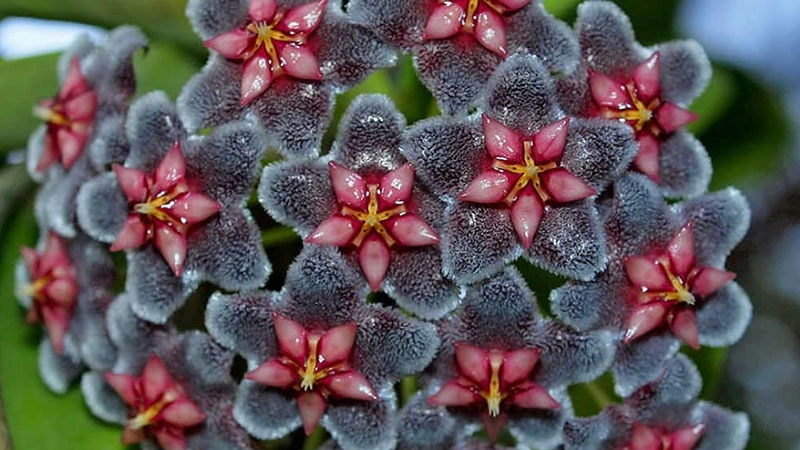
These are star-shaped, deep maroon to black flowers having a yellow crown in the center. Hoya plant is a trailing, vining houseplant having teardrop-shaped leaves with tints of red, bronze, and green. If well maintained, Black Hoya puts out a bunch of small blooms that release a sweet scent.
| Botanical Name | Hoya ciliata |
| Mature Size | 12-20 feet |
| Soil Conditions | Well-drained |
| Watering Requirements | Once a week |
| Sunlight Exposure | Indirect, diffused sunlight |
| Bloom Time | Late spring to fall |
Black Bat Flower
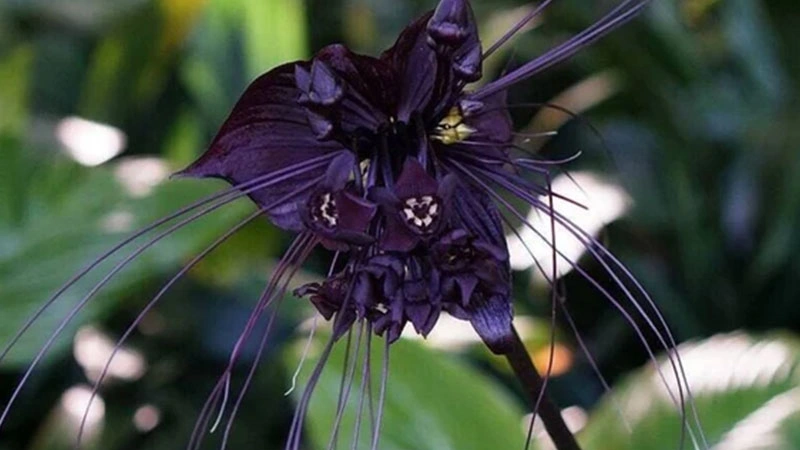
This stunning bat-shaped flower has a long filament that hangs down up to 2 feet. Black bats are grown in semi-tropical regions and demand good humidity to nourish. The health of this plant is based on the size of the flower. The plant grows well in the sheds of other trees. However, if positioned indoors, keep them in a warm, indirect, sun-lit area.
| Botanical Name | Tacca chantrieri |
| Mature Size | Up to 3 feet tall |
| Soil Conditions | Well-drained, rich soil |
| Watering Requirements | 0.8 cup of water every 7 days |
| Sunlight Exposure | Partial shed |
| Bloom Time | Spring to summer |
Black Hollyhock
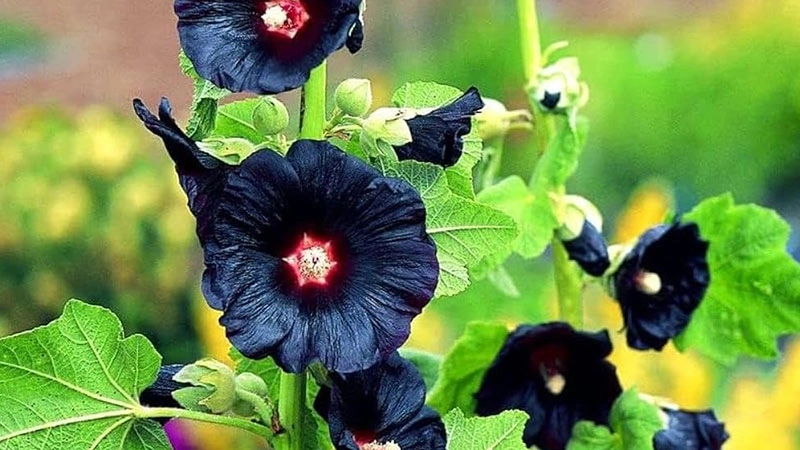
It is a perennial plant having deep green leaves and blackish-purple flowers. Black Hollyhocks or Blacknights have tall spikes covered with single or double, cup-shaped flowers from top to bottom. The leaves of the plant are large and palmate. They attract pollinators in the garden and are a great fit to add drama and make an impressive backdrop to the borders.
| Botanical Name | Alcea rosea ‘Nigra’ |
| Mature Size | Up to 6 feet tall |
| Soil Conditions | Well-drained |
| Watering Requirements | Once or twice a week |
| Sunlight Exposure | Full sun to partial shade |
| Bloom Time | Mid to late summer |
Black Tulips
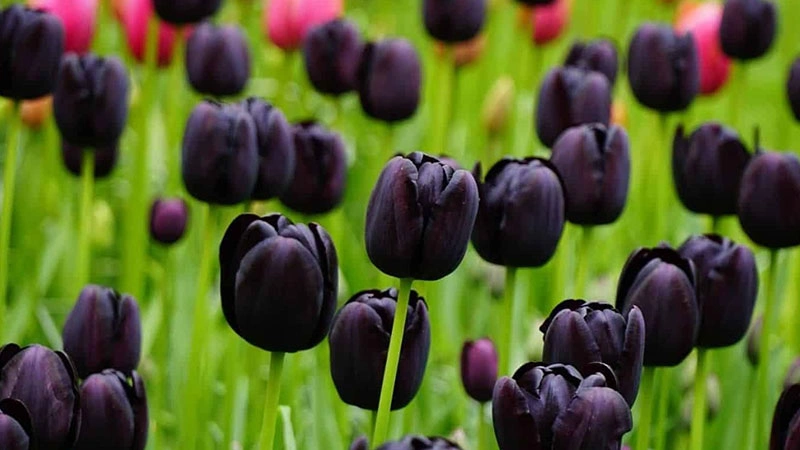
Having a deep maroon-to-black texture, these flowers are a classic choice for spring bulbs and flower beds. Black Tulips, or Queen of the Night flowers, symbolize perfect love and elegance, making them an amazing choice for Goth followers. Some other varieties of black tulips that you can grow include Paul Scherer, Black Parrot, Black Hero, Café Noir, Ronaldo, Uncle Tom, etc.
| Botanical Name | Tulipa ‘Queen of Night’ |
| Mature Size | Up to 2 feet tall |
| Soil Conditions | Well-drained |
| Watering Requirements | 0.8 cup of water in every 9 days |
| Sunlight Exposure | Full sun |
| Bloom Time | Late spring |
Black Hyacinth
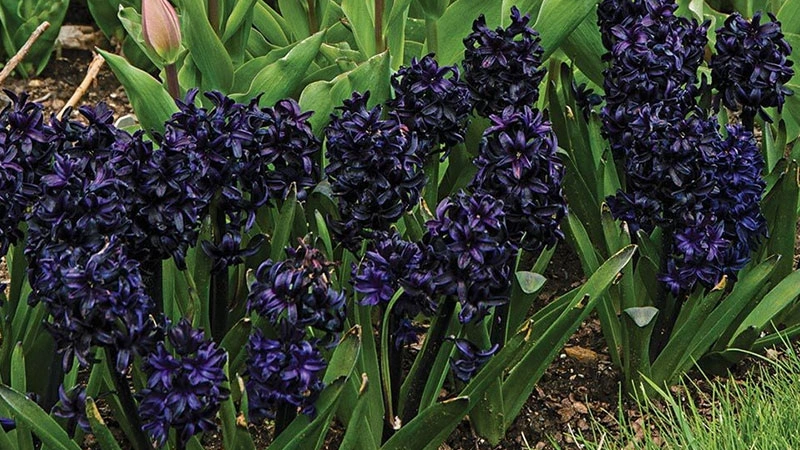
The flowers of Black Hyacinth are considered to be the darkest, with a purple to almost black hue. They bloom in a bunch around the upper end of the stem, with 5–6 petals. Black Hyacinths are easy to grow in pots and containers and can be planted in coastal, cottage, and cut flower gardens. Their high fragrance and appealing texture are enough to uplift your mood. However, they do not attract pollinators and can be a bit toxic as well.
| Botanical Name | Hyacinthus orientalis ‘Midnight Mystic’ |
| Mature Size | 6-12 inches |
| Soil Conditions | Moist but well-drained |
| Watering Requirements | Once or twice a week |
| Sunlight Exposure | Full sun to partial shade |
| Bloom Time | Early to mid-spring |
Design a Stunning Gothic Garden for Your House
Wanna design the garden of your dreams? Then, open the wrought gates and dive into the dark, reflecting pools of creativity by considering the following points:
- Layout
For the layout, you can draw inspiration from classic Gothic books and movies and add rusty iron gates, creepy vines covering pergolas, design dark corners, and a lot more to reflect your evil imagination. Prefer to avoid straight lines and pathways; instead, make them complex, curved, and uneven.
- Accessories
To create a more spectacular view, you can add traditional Gothic elements such as urns, fountains, statuary, cherubs, saints, and angels. Furthermore, a well-worn bench and rusty, cage-like outdoor lanterns throw spooky shadows and dramatic appeal.
- Lighting
Lighting plays a crucial role in generating a dark aura. Install spotlights on favorite garden statues, up-lighting trees, pathway lighting, and other features that will provoke the imagination at night.
All these ways will be wickedly helpful in designing an evil-themed Goth garden filled with suspicious Gothic flowers. Not just outdoor space, you can also plant these flowers on your balcony garden, roof garden, and indoor spaces to combine beauty with deadly elements.
Dare your friends to take a walk through your Goth Garden on a new moon night!
What are some plants with black foliage?
Plants with black foliage include Astilbe Dark Side of the Moon, Coleus ‘Black Prince’, Heuchera ‘Black Pearl’, Grass Black Mondo, Mangave ‘Black Magic’, Purple Fountain Grass, Weigela Dark Horse, etc.
What do Gothic flowers represent?
In Gothic gardens, the flowers represent mystery, farewell, rebirth, horror, transformation, elegance, deep passion, reflection, and others.
Why add Goth flowers to the garden?
Gothic flowers can be added to the garden to give a mystery, spooky, and gloomy contrast to it.
- Goth Garden: Spooky and Beautiful, National Garden Bureau
- Bat Flower – UF/IFAS Gardening Solutions, University of Florida
- Helleborus Niger, Wikipedia

